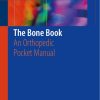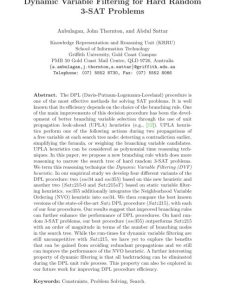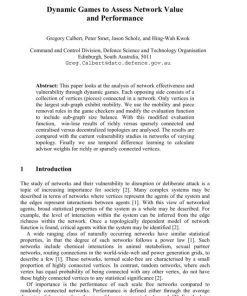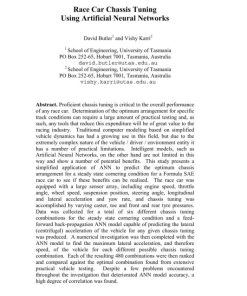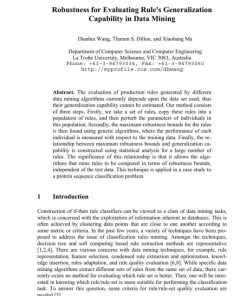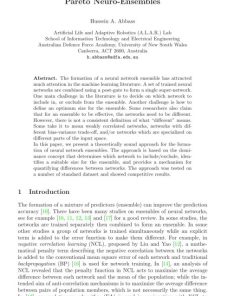LNAI 2903 Evaluating a Nearest Neighbor Method to Substitute Continuous Missing Values 1st Edition by Eduardo Hruschka, Estevam Hruschka Jr, Nelso Ebecken ISBN 9783540206460 354020646X
$50.00 Original price was: $50.00.$25.00Current price is: $25.00.
Authors:Eduardo R. Hruschka, Estevam R. Hruschka Jr.; Nelson F. F. Ebecken , Tags:AI 2003: Advances in Artificial Intelligence , Author sort:Eduardo R. Hruschka, Estevam R. Hruschka Jr. & Ebecken, Nelson F. F. , Languages:Languages:eng , Published:Published:Nov 2003
LNAI 2903 Evaluating a Nearest Neighbor Method to Substitute Continuous Missing Values 1st Edition by Eduardo Hruschka, Estevam Hruschka Jr, Nelso Ebecken – Ebook PDF Instant Download/Delivery. 9783540206460 ,354020646X
Full download LNAI 2903 Evaluating a Nearest Neighbor Method to Substitute Continuous Missing Values 1st Edition after payment
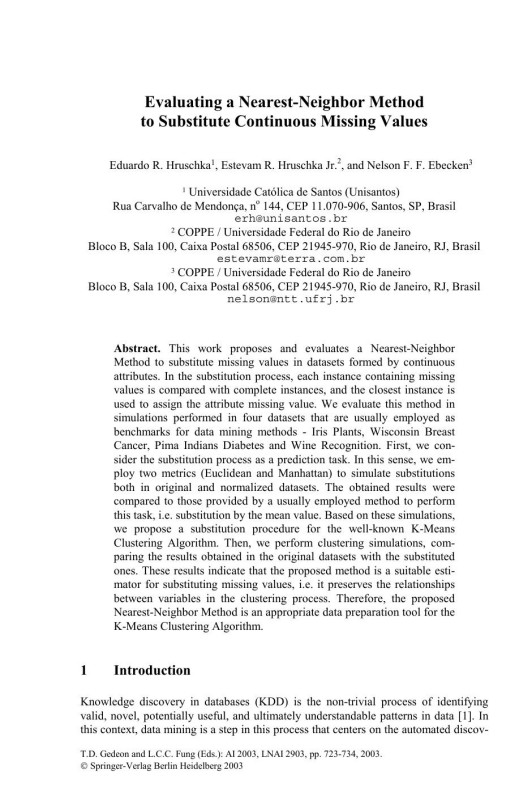
Product details:
ISBN 10: 354020646X
ISBN 13: 9783540206460
Author: Eduardo Hruschka, Estevam Hruschka Jr, Nelso Ebecken
This work proposes and evaluates a Nearest-Neighbor Method to substitute missing values in datasets formed by continuous attributes. In the substitution process, each instance containing missing values is compared with complete instances, and the closest instance is used to assign the attribute missing value. We evaluate this method in simulations performed in four datasets that are usually employed as benchmarks for data mining methods – Iris Plants, Wisconsin Breast Cancer, Pima Indians Diabetes and Wine Recognition. First, we consider the substitution process as a prediction task. In this sense, we employ two metrics (Euclidean and Manhattan) to simulate substitutions both in original and normalized datasets. The obtained results were compared to those provided by a usually employed method to perform this task, i.e. substitution by the mean value. Based on these simulations, we propose a substitution procedure for the well-known K-Means Clustering Algorithm. Then, we perform clustering simulations, comparing the results obtained in the original datasets with the substituted ones. These results indicate that the proposed method is a suitable estimator for substituting missing values, i.e. it preserves the relationships between variables in the clustering process. Therefore, the proposed Nearest-Neighbor Method is an appropriate data preparation tool for the K-Means Clustering Algorithm.
LNAI 2903 Evaluating a Nearest Neighbor Method to Substitute Continuous Missing Values 1st Edition Table of contents:
Chapter 1: Introduction
- 1.1. The Importance of Handling Missing Data
- 1.2. Types of Missing Data
- 1.3. Impacts of Missing Data on Data Analysis
- 1.4. Overview of Imputation Methods
- 1.5. Objective of This Book
Chapter 2: Fundamentals of Missing Data
- 2.1. Definition and Types of Missing Data
- 2.2. Mechanisms of Missingness (MCAR, MAR, MNAR)
- 2.3. Effects of Missing Data on Statistical Inference
- 2.4. Common Approaches for Missing Data Handling
Chapter 3: Nearest Neighbor Imputation Methods
- 3.1. The Concept of Nearest Neighbor
- 3.2. k-Nearest Neighbor (k-NN) Imputation
- 3.3. Distance Measures for k-NN
- 3.4. Algorithmic Variants of k-NN Imputation
- 3.5. Advantages and Limitations of k-NN Imputation
Chapter 4: Data Preprocessing for Imputation
- 4.1. Preparing the Data for Imputation
- 4.2. Normalization and Scaling of Features
- 4.3. Handling Categorical and Continuous Data
- 4.4. Managing Outliers in the Context of Imputation
Chapter 5: Evaluating Imputation Techniques
- 5.1. Evaluation Metrics for Imputation Quality
- 5.2. Error Measures: MAE, RMSE, etc.
- 5.3. Cross-validation and Experimental Design
- 5.4. Comparing Nearest Neighbor Imputation with Other Methods
- 5.5. Case Studies and Application Scenarios
Chapter 6: Nearest Neighbor Method in Depth
- 6.1. Detailed Walkthrough of the Nearest Neighbor Algorithm
- 6.2. Advanced Variants: Weighted k-NN, Radius Search
- 6.3. Algorithm Complexity and Efficiency
- 6.4. Implementation in Python/ R
- 6.5. Real-World Applications of Nearest Neighbor Imputation
Chapter 7: Case Studies and Practical Applications
- 7.1. Case Study 1: Medical Data
- 7.2. Case Study 2: Financial Time Series
- 7.3. Case Study 3: Sensor Networks
- 7.4. Case Study 4: Social Media Data
- 7.5. Challenges and Lessons Learned
Chapter 8: Advanced Topics in Missing Data Imputation
- 8.1. Imputation in High-Dimensional Data
- 8.2. Handling Multiple Missing Values and Multiple Imputation
- 8.3. Integrating Nearest Neighbor with Other Methods (e.g., Bayesian, Matrix Factorization)
- 8.4. Recent Advances in Machine Learning for Imputation
Chapter 9: Conclusion and Future Directions
- 9.1. Summary of Key Findings
- 9.2. Emerging Trends in Missing Data Imputation
- 9.3. Open Challenges in the Field
- 9.4. Future Research Directions
References
- Comprehensive list of references cited throughout the book
People also search for LNAI 2903 Evaluating a Nearest Neighbor Method to Substitute Continuous Missing Values 1st Edition:
nearest neighbor analysis example
evaluating a random forest model
evaluating numerical expressions
evaluate the expression. if necessary round to the nearest hundredth
You may also like…
eBook PDF
LNAI 2903 Pareto Neuro Ensembles 1st Edition by Hussein Abbass ISBN 9783540206460 354020646X


